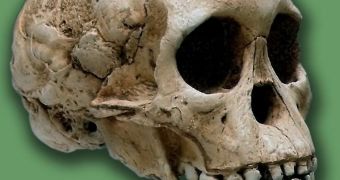Dean Falk, an evolutionary anthropologist at the Florida State University (FSU), led a team of experts that now believes it has an explanation for why the brains of hominins grow larger and increasingly complex. The results come from studying one of the most famous fossils in the world.
The team analyzed anthropological features of the first australopithecine ever discovered, the Taung fossil. Two of these features were of particular interest to investigators, who now believe that the evolution of the brain was the results of complex, interrelated dynamics occurring at childbirth.
In a paper published in the May 7 issue of the esteemed journal Proceedings of the National Academy of Sciences (PNAS), investigators say that the new bipedal species benefited extensively from the increased skull size.
The evolution of the human brain is perhaps one of the most mysterious aspects related to our species' history. Neanderthals, for example, had much larger brains than we do, as far as volume goes, but that did not help them out very much. Comparatively, we are a lot smarter than they were.
“These findings are significant because they provide a highly plausible explanation as to why the hominin brain might grow larger and more complex,” explains Falk. He adds that his study focused on the fossil's persistent metopic suture and endocast.
The former is an unfused seam in the frontal bone of the skull, whose role is to enable an infant's skull to remain pliable during birth. This adaptation allows the baby to come out of the birth canal without suffering too much damage.
Unlike primates, where this suture closes down very soon after birth, human children only exhibit completely sealed metopic sutures around the age of 2. This enables the skull to accommodate the rapid growth of the brain.
The second feature was the endocast, which is the imprint that the cortex leaves on the inside of the skull. Experts can use it to analyze the form and structure of the cortex and, by extension, the brain, EurekAlert reports.
It is important to note here that the Taung fossil is around 2.5 million years old. Experts analyzed it using 3D computer tomography (CT), and determined that the persistent metopic suture appeared as an evolutionary adaptation for giving birth to children whose skulls can accommodate larger brains.
The frontal bone structure also emerged in relation to the shift to a rapidly growing brain after birth, the team goes on to say. The expansion of the frontal lobes, which code for higher cognitive functions in humans, is a result of these adaptations.
“The persistent metopic suture, an advanced trait, probably occurred in conjunction with refining the ability to walk on two legs. The ability to walk upright caused an obstretric dilemma,” Falk explains.
“Childbirth became more difficult because the shape of the birth canal became constricted while the size of the brain increased. The persistent metopic suture contributes to an evolutionary solution to this dilemma,” he concludes.

 14 DAY TRIAL //
14 DAY TRIAL //